the masterworks show




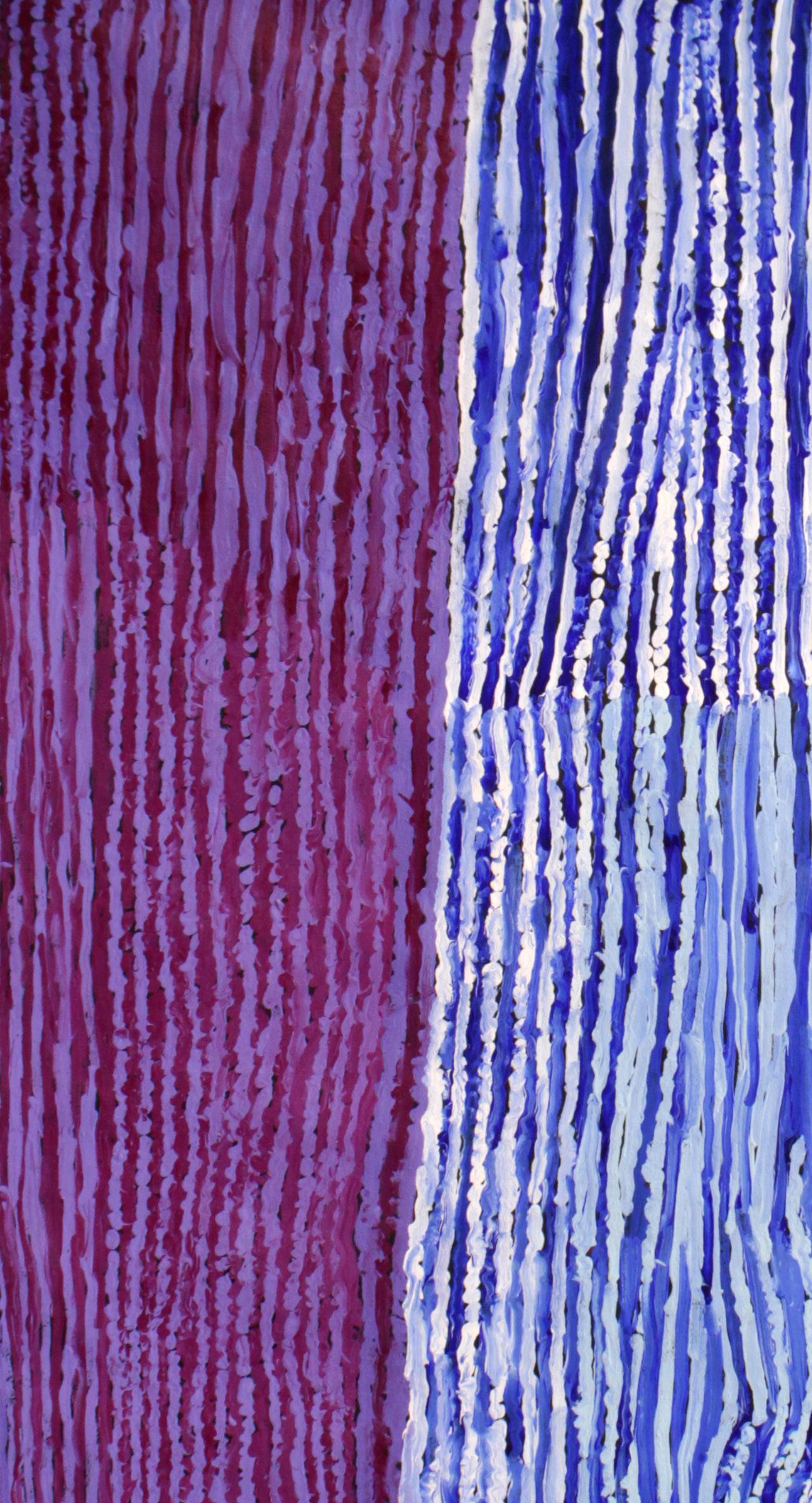
Carbiene McDonald was born in Papunya in 1961, son of Snowy McDonald and as a young man, he traveled back to his father’s homelands and inherited his Tjukurrpa (Dreaming). This Dreaming is associated with a series of waterholes running between Docker River and Kata Tjuta. Specifically, it includes four important sites: Petermann Ranges, Docker River, Kalaya Murrpu (Blood’s Range) and Mulyayti near Kata Tjuta.
Carbiene’s work embodies quality of innovation within tradition, and his practice of filling the canvas with colored squares of loose acrylic paint creates work of immense depth and sophistication. Having only taken up painting later in life in 2018, his passion for painting coupled with his extreme dedication and enthusiasm has led him to quickly make a name for himself.
Winner of the prestigious Hadley’s Art Prize (2019), finalist in the Vincent Lingiari Art Award (2019) his work is held in Art Gallery of NSW Collection, Charles Darwin University Collection and in private collections in Australia.
Art Gallery of New South Wales
Charles Darwin University Collection
The Hassell Collection
Four Dreamings, 2019 48 x 36 inches (122 x 91cm)
Acrylic on Belgian linen Papunya Tjupi Artists Catalog #636-19
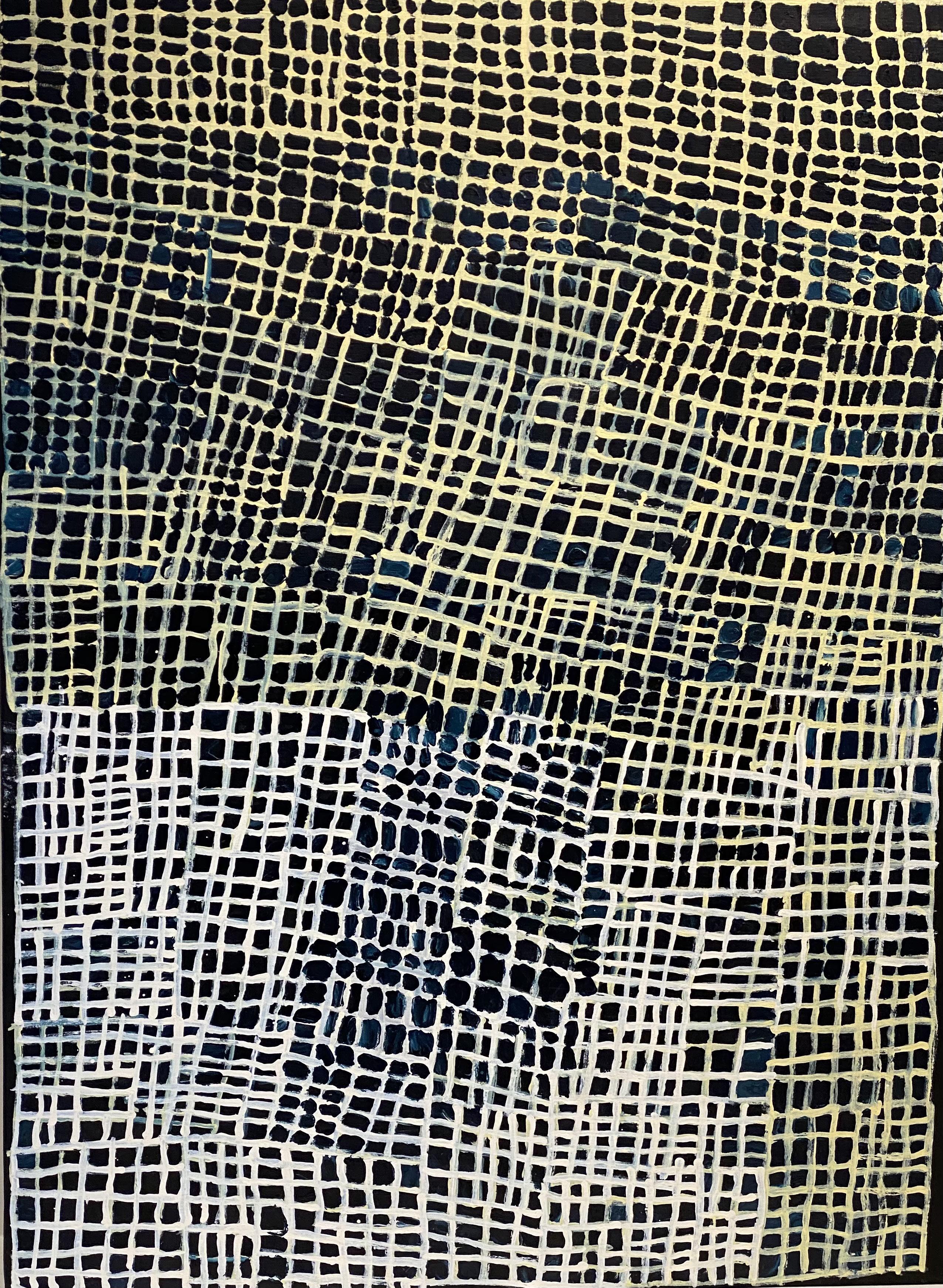
Timothy Cook has been creating paintings, prints and carvings at Jilamara since 1999. Born in 1958 on Melville Island, where he lives and works today, Timothy is a member of the Jilamara Arts & Crafts Association. Melville Island lies in the eastern Timor Sea about 60km north off the coast of Darwin in the Northern Territory, where the Indigenous people have lived for over 40,000 years. Together with Bathurst Island and nine smaller islands, it forms the Tiwi Islands.
Cook’s art is very personal to him; he likes the ‘old designs’ which he learned from his elders. He especially likes dots (pwanga) as elements of his designs; dots are his ‘favourite special’ due to the fact that ochre dots are applied to his face for ceremonies. The dots are applied by his bunji – a kinship relationship term which means mate, or in-law. Cook expresses himself through his loose, gestural, spacious designs. He paints with a palette of exclu sively natural ochres.
Featuring circular and cross motifs, Cook’s paintings are strongly connected to aspects of Tiwi ceremonial prac tice, particularly the Kulama (yam ceremony) and Pukumani (funeral ceremony), as well as stories of Purukapali, one of the great mythological Tiwi ancestral figures.
His artworks are highly sought after for major collections both nationally and internationally. In 2012, he won the Major Award at the prestigious Telstra National Aboriginal & Torres Strait Islander Art Awards, where he had been a Finalist in 2004, 2005, 2008, 2009, 2010 and 2011. In 2018 Cook’s work was selected for the inaugural King and Wood Mallesons Contemporary ATSI Art Prize.
South Australia Museum
National Gallery of Victoria
Patrick Corrigan Collection
Queensland Art Gallery Collection
Kulama (Yam Ceremony), 2012 48 x 36 inches (122 x 91cm)
Natural earth pigment on linen Jilamara Artists Catalog #20-12
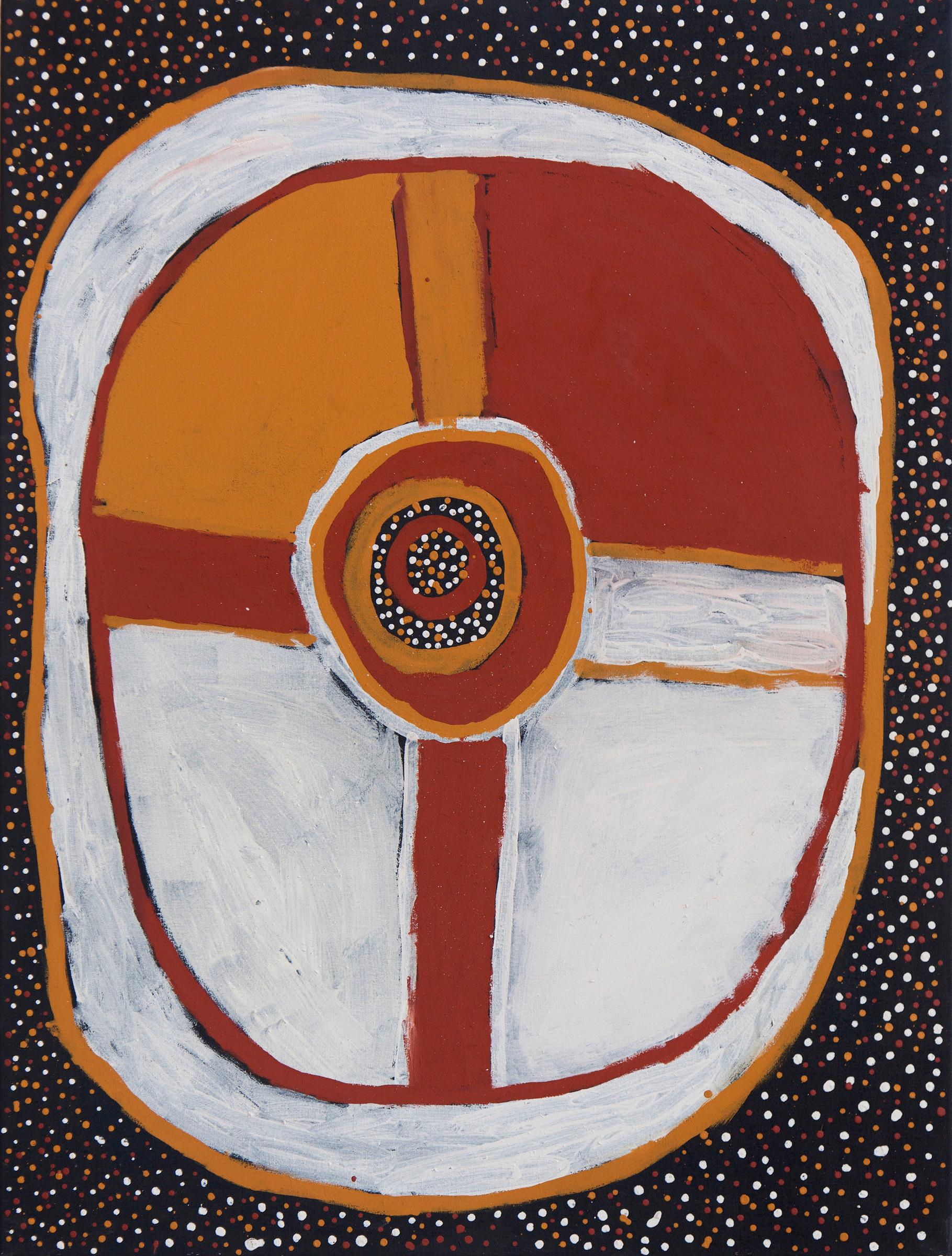
Nyunmiti Burton was born in Alice Springs, and grew up in Pukatja (Ernabella) where she now lives and works. In ‘Kungkarangkalpa’ Nyunmiti paints the Seven Sisters songline. Songlines have been a central feature of First Nations cultures for over 80,000 years. Songlines trace astronomy and geographical elements from ancient stories, carry laws and describe how these things have helped shape the landscape as it is now.
“I heard these stories from my father, mother and grandfathers. I think about the future of the country for the next generation. The Seven Sisters story has always been important for Anangu women and it is more important today than ever before. It is a story that celebrates women’s leadership. This is the oldest sister, and her leadership guided the other sister away from the dangers of the world. The oldest sister made sure that the seven sisters stayed togeth er and that no one was left behind. The oldest sister protected everyone and made sure all the women were safe. This was the oldest sister’s story and it is the story of all Aboriginal women leaders in Australia today. This is the power of women leaders. We can make all the women coming behind us fly.” - Nyunmiti Burton
Nyunmiti was awarded the 2020 Roberts Family Aboriginal and Torres Strait Islander Prize and highly commended in the Wynne Prize 2020.
Art Gallery of South Australia
National Gallery of Australia
Museums & Art Gallery of the Northern Territory
Araluen Art Centre
Art Gallery of New South Wales
Kungkarangkalpa (Seven Sisters), 2016 48 x 78 inches (122 x 198cm)
Acrylic on Belgian linen
Tjala Arts Catalog #829-16
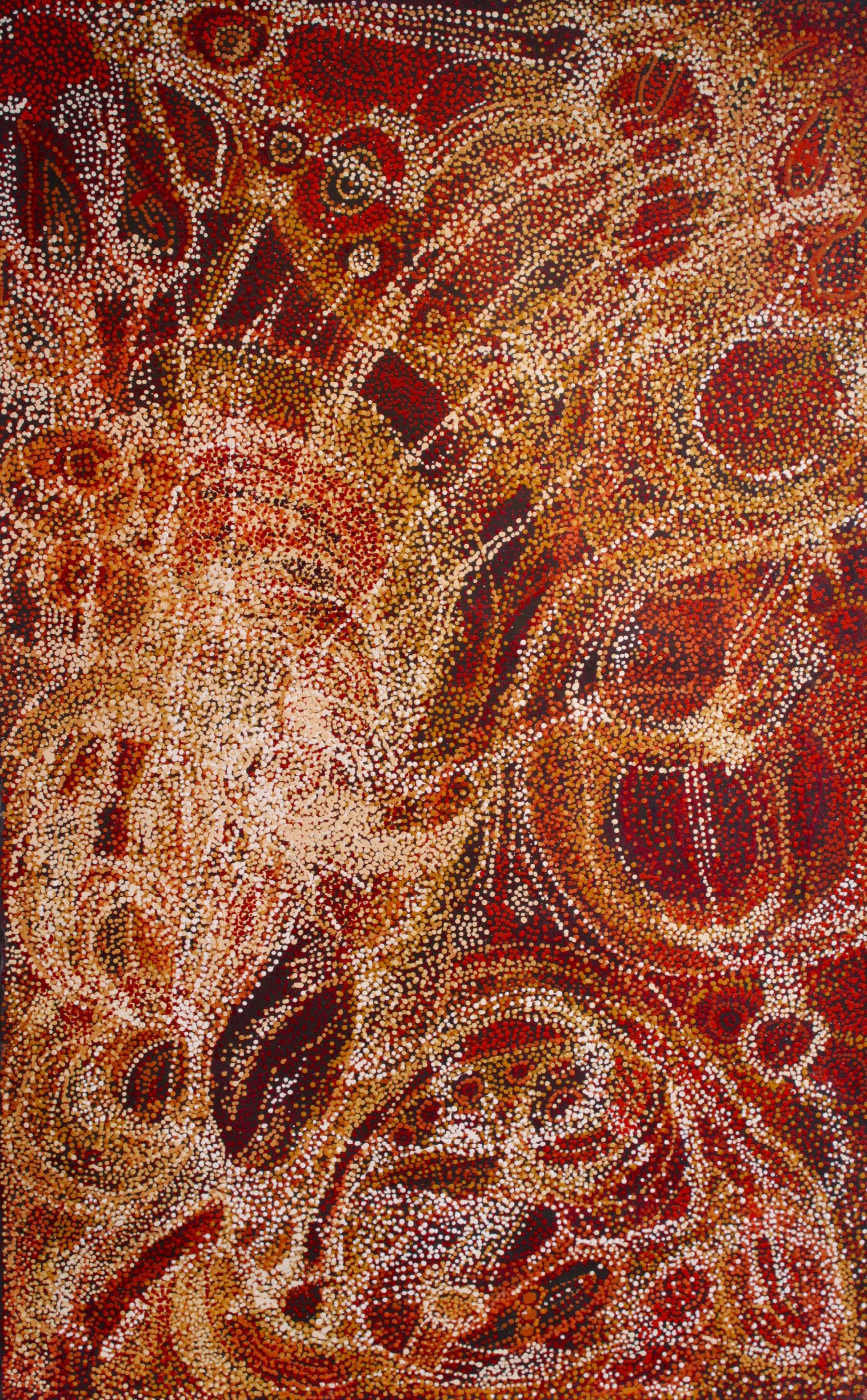
Bob Gibson Tjungarrayi was born at Papunya in 1974, before moving with his family to Tjukurla during the Papunya Tula movement of the 1980s, where many Ngaanyatjarra people moved to be closer to their ancestral homelands. Bob’s mother Mary Gibson, also a leading Tjarlirli artist, is from the country of Kulkurta, his father’s country was near Patjarr.
Gibson has been painting with Tjarlirli Art since 2007 and quickly found a unique rhythm and approach to painting; bold colors and an inimitable freedom, expressing ancient stories with contemporary flair. Gibson is a vibrant character who is well loved within his community and offers support to many family members. A keen Sydney Swans supporter, he loves listening to all music, especially the local bush bands.
Looking at a Bob Gibson painting feels a little like spending time with the artist himself. Gibson’s bold, playful presence in the studio is contagious; each canvas brings wild shapes and expressive line met with decisive markmaking and confident realization of country. His highly unique representations of tjukurpa are an intersection of traditional storytelling and a spirited contemporary artisic practice. This work is important as it speaks to the complex layers and tensions between cultural, historical and modern influences.
National Gallery of Victoria
Art Gallery of New South Wales Queensland Art Gallery
GOMA
ArtBank
BOB GIBSON
Patjantja, 2014
30 x 30 inches (75.5 x 75.5cm)
Acrylic on Belgian linen
Tjarlirli Artists Catalog #14-481
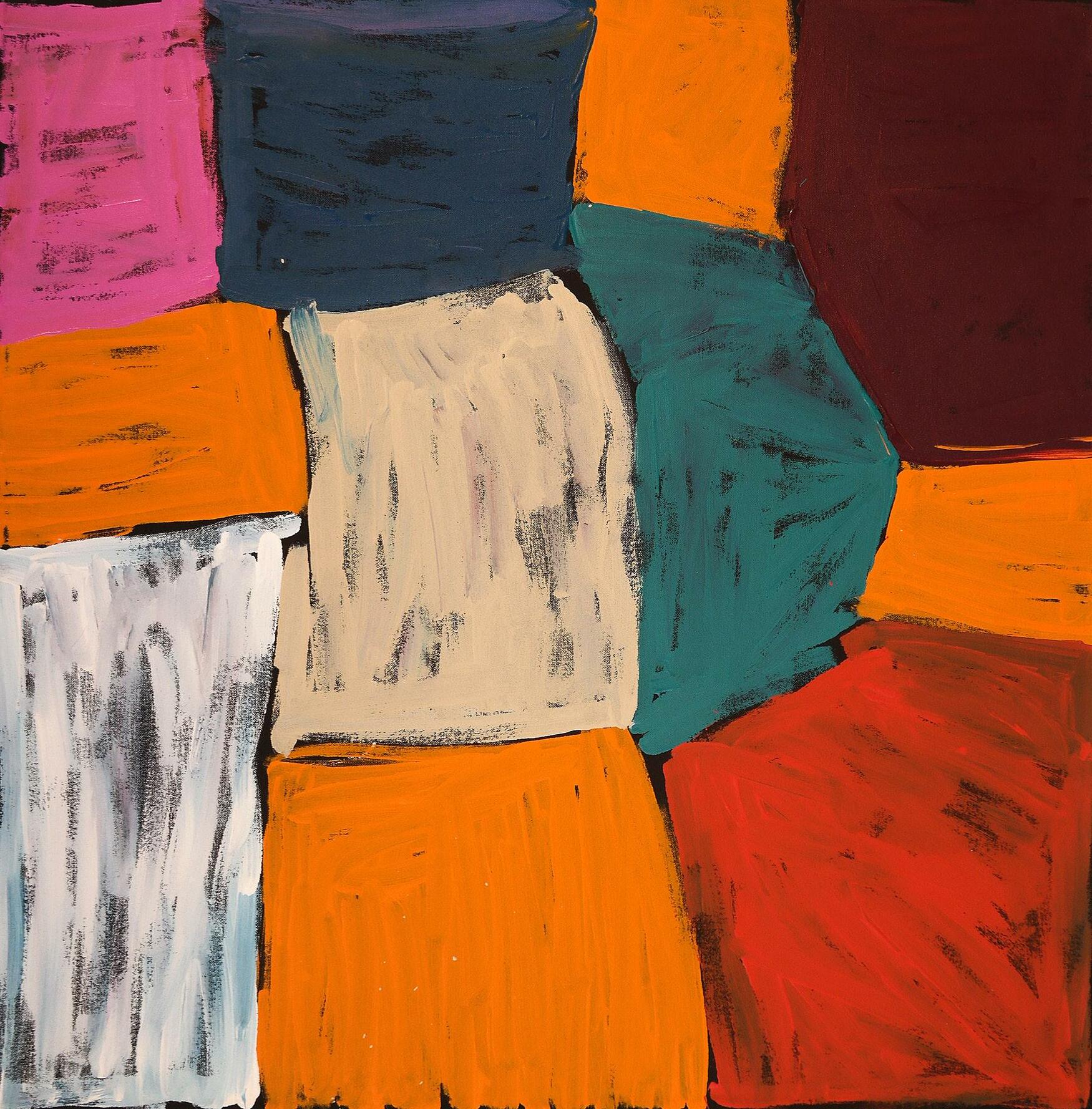
AUSTRALIAN, GIJA, C. 1944-2016
Churchill Cann painted for many years, influenced by the first generation of artists that established the Warmun contemporary art movement. His precise textures, lucid compositions of country, haunting mystery and the gravity of marginalized histories are marks of confidence and surety.
Mr. Cann worked as a stockman from an early age on Texas Downs cattle station, which lies to the east of Warmun. He moved around his own country and also worked at Alice Downs, Mabel Downs Spring Creek and Lissadell stations. Riding in the bush was a way of being in the country and absorbing knowledge from his elders
while working in a white man’s world caring for cattle. Mr. Cann was knowledgeable about traditional healing practices, expertise he inherited from his father. These life experiences informed his work.
In a 2012 interview, Mr. Cann was asked how he first started painting. His initial response led him to childhood, when he’d watch his uncle and grandfather make things. Of his uncle, Cann said, ‘Whatever broke, he’d renew ‘em.’
The act of painting is akin to the act (and memory) of making things – of heating horse shoes over a fire, bashing them into shape with a rock, working with sugarbag wax, straightening bamboo spears and preparing kangaroo sinew.
Mr. Cann was a very serious and focused practitioner at work, yet his character is playful to the bone. He entitled a 2013 solo show – Cheeky Dog. This name is based on his Dreaming the Jarrinyin; a kind of devil dog described by Mr. Cann as having ‘a long neck like a giraffe’.
He was the winner of the 2013 WA Indigenous Artist Award at the Art Gallery of Western Australia.
National Gallery of Australia
National Gallery of Victoria
Queensland Art Gallery
Art Gallery of Western Australia
Musée du Quai Branly, Paris
Ngarragoon - Texas Country, 2013
60 x 60 inches (150 x 150cm)
Natural earth pigment on canvas
Warmun Arts Catalog #643-13

AUSTRALIAN, PITJANTJATJARA, C. 1935 - 2018
Sandy Brumby grew up at an outstation called Victory Downs near to Pukatja (formerly Ernabella) with his mother, father, brother and sister. Early jobs included working at a cattle station called Mount Cavanagh near Kulgera over the threshold of the Northern Territory, where he mustered bullocks, fixed fences and looked after the cows.
The first time he picked up a paintbrush was in the Ninuku Arts center, an Aboriginal art and craft center established in 2008. He produced work almost every day from then, saying he was spontaneously documenting the life of his people.
Brumby’s paintings have a spirited, raw character displaying a powerful communication with his culture and his people. The iconography in his work is reminiscent of symbols that are sometimes seen in rock or cave paintings around Uluru and Kata Tjuta. His paintings are raw and bold, demonstrating a strong connection to his country and his culture. He has a deep love of color and uses a broad palette when he paints, selecting – with natural intuition – colors that sing beautifully together.
In a short period of time his paintings gained significant attention and were acquired by notable public collections, including the National Gallery of Victoria, The National Gallery of South Australia and Queensland Art Gallery.
Art Gallery of South Australia National Gallery of Victoria Queensland Art Gallery
Artbank
Victory Downs, 2011 42 x 24 inches (107 x 61cm)
Acrylic on Belgian linen Ninuku Artists Catalog #11543

Bugai Whyoulter is a Kartujarra woman and a senior custodian of the lands surrounding Kunawarritji (Canning Stock Route Well 33) in Western Australia. Born at Pukayiyirna, now known as Balfour Downs Station, Whyoulter is of the pujiman (meaning bush or desert born and dwelling) generation, traveling the land around Jigalong, Nullagine, Punmu and Kunawarritji with her family, moving with the seasons from water source to water source.
Whyoulter’s family traveled what was later known as the Canning Stock Route, an 1850 kilometre-long track that traverses the Great Sandy, the Little Sandy and the Gibson Deserts. As a young woman, Whyoulter returned to the same locations, travelling up and down large tracts of the Canning Stock Route as a cattle drove. She continued to live a pujiman life until 1963, when she, her husband and her family settled at Jigalong Mission. They were with the last of the Martu people to leave the desert. From Jigalong, Whyoulter moved to several communties before relocating to Kunawarritji community, where she continues to live today. It was in Kunawarritji community that Whyoulter began to paint, learning from her relatives, the renowned artists Nora Nungabar (Nyangapa) (dec.) and Nora Wompi (dec.). The three women often painted together developing several intimate collaborative works while mentoring Whyoulter’s practice.
Today Whyoulter is considered one of the most established Martumili Artists reknown as a master of color, ges ture, and subtlety. Her self-reflective works are layered with distinctively delicate brush marks, with subtle color shifts representing the significant landforms of Kunawarritji, including water sources, and desert flora. Whyoul ter’s approach to her practice is intuitive and gestural, effortlessly transferring intimate knowledge of the land and its stories upon her canvases.
Whyoulter has garnered significant recognition for her work; selected for the Bankwest Contemporary Art Prize and the Hedland Art Award in 2012, the Western Australian Indigenous Art Award in 2010, and the Telstra Na tional Aboriginal and Torres Strait Islander Art Awards in 2013, 2018, 2019 and 2021, where she was awarded the prestigious General Painting Award her work Wantili in 2021.
National Gallery of Victoria
Art Gallery of New South Wales
Queensland Art Gallery of Modern Art
BUGAI WHYOULTER
Wantili, 2014
36 x 36 inches (91 x 91cm)
Acrylic on Belgian linen
Martumili Arts Catalog #14-62
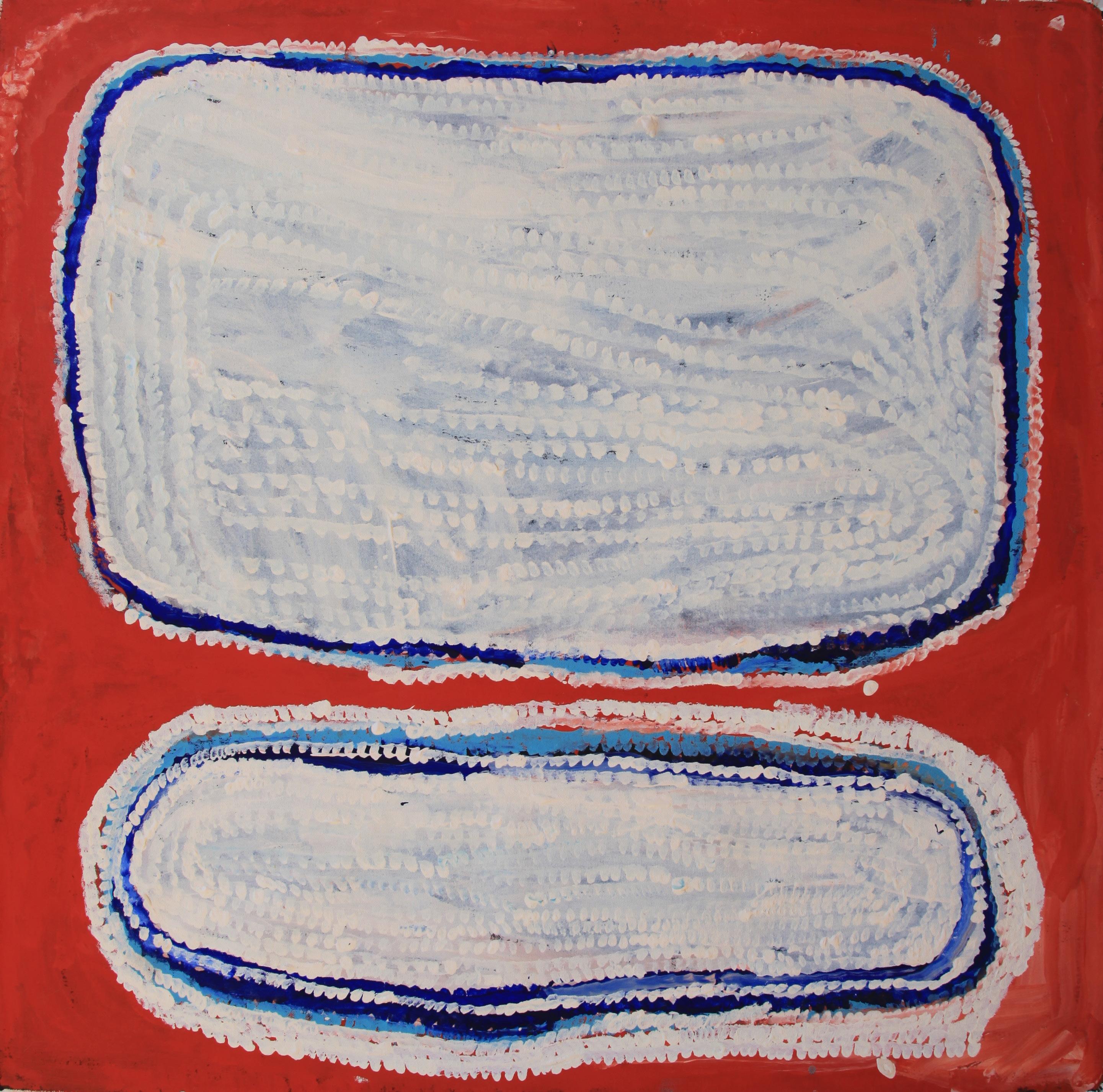
AUSTRALIAN, ANANGU, C. 1940 - 2018
Kunmanara was an acclaimed artist and important senior Amata law man from the Anangu Pitjantjatjara Yanku nytjatjara (APY) Lands, South Australia. Drawing on his innate knowledge of land and Law, Mr Ken combined traditional Anangu culture with a vibrant colour palette and striking linear compositions to achieve a highly sophisticated and contemporary aesthetic.
Mr Ken was renowned for his distinctive portrayals of the undulating sandhills of his Country, Tali, and Kulata Tjuta, which celebrate the importance of spears in Anangu culture, and the deep connection to those past and present, who have fought to protect Country. Mr Ken believed that it was the responsibility of the Amata senior men to teach the younger generations how to carve Kulata, in order to keep the tradition strong and alive.
Prior to his passing in 2018, Mr Ken was named as a finalist in the prestigious Wynne Prize at the Art Gallery of New South Wales, Sydney and in the 35th Telstra National Aboriginal and Torres Strait Islander Art Awards at the Museum and Art Gallery of the Northern Territory, Darwin for the second consecutive year. His paintings are found in most public institutions in Australia and several significant private collections nationally and interna tionally.
National Gallery of Australia Queensland Art Gallery
National Gallery of Victora
Art Gallery of New South Wales
Artbank
Araluen
Tali - Sand Hills, 2016
48 x 59.8 inches (122 x 152cm)
Acrylic on Belgian linen
Tjala Art Center Catalog #434-16
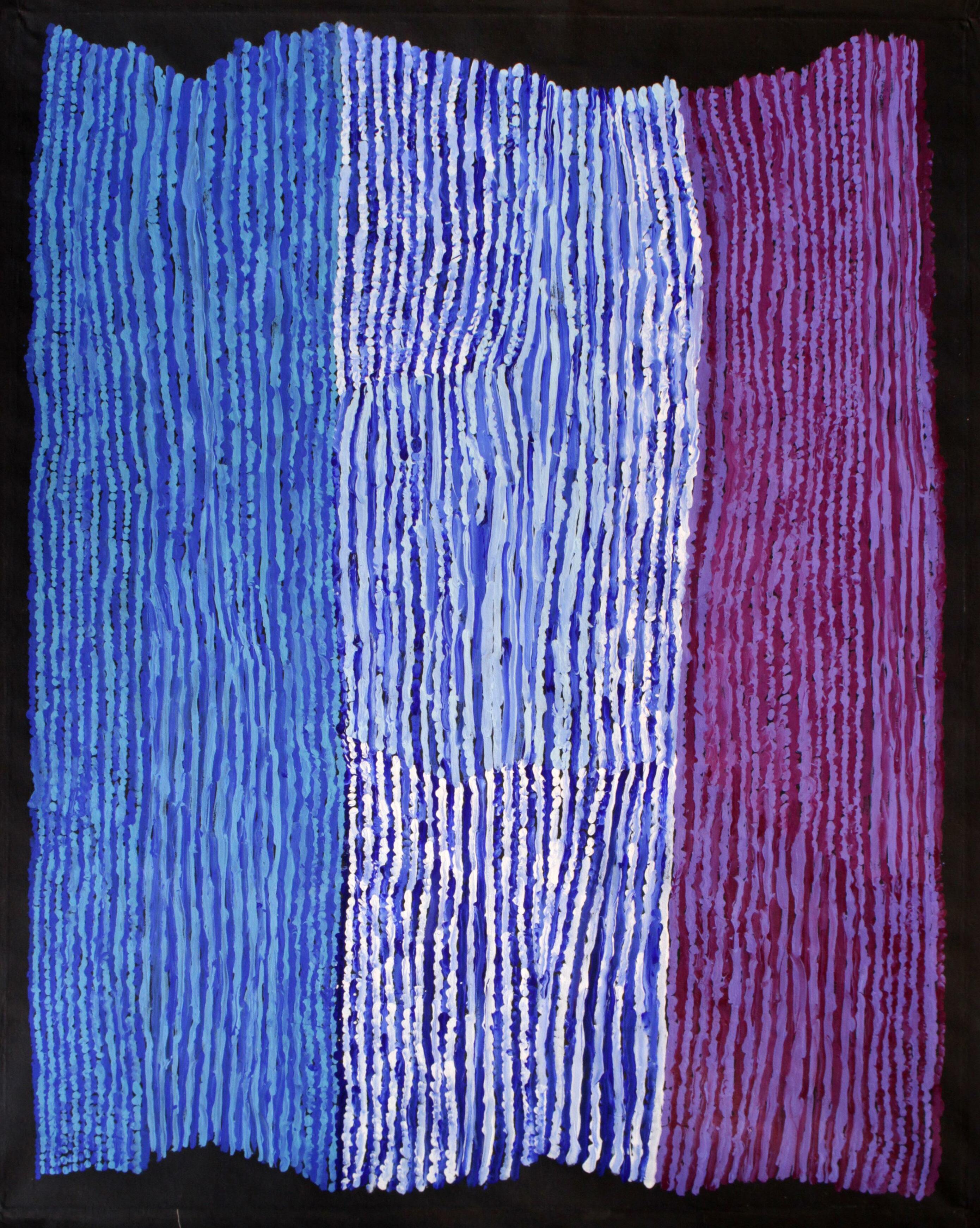
Nyilyari Tjapangati is the second son of the well known artist Pinta Pinta Tjapanangka and the younger brother of Matthew Tjapangati. He was born in approximately 1965. Nyilyari completed his first paintings for Papunya Tula Artists as early as 1999 but didn’t begin painting regularly for the company until 2004. His paintings relate to sites around Kaakuratintja (Lake MacDonald) and west to Mt Webb and Wilkinkarra (Lake Mackay), a vast region that occupys the border between Western Australia and the Northern Territory. These are all sites that were also commonly referred to in his father’s paintings.
Nyilyari’s works has become synonymous with producing distinctive renditions of ancestral stories. Repeating motifs reflect traditional forms and narratives while the spaces or intervals between the motifs encourage our eye to drift from one element to the next. Patterns of brush stroke, colour and shape are similar to the patterns of sound over timed intervals. This powerful and distinct form of visual rhythm has captured the attention of institutions and collectors the world over.
Nyilyari has exhibited in significant exhibitions including the landmark 2009 exhibit, ‘Nganana Tjungurrayi Tju kurrpa Nintintjakitja: We are Here Sharing our Dreaming’, Washington Square East Galleries, New York, USA.
Araluen Art Centre
National Gallery of Australia
Art Gallery of New South Wales
National Gallery of Victoria
Art Gallery of South Australia
Harvard Art Museum
Toledo Musuem of Art
Untitled, 2012
42” x 48” (107 x 122cm)
acrylic on Belgian Linene
Papunya Tula Artists #NT1206020
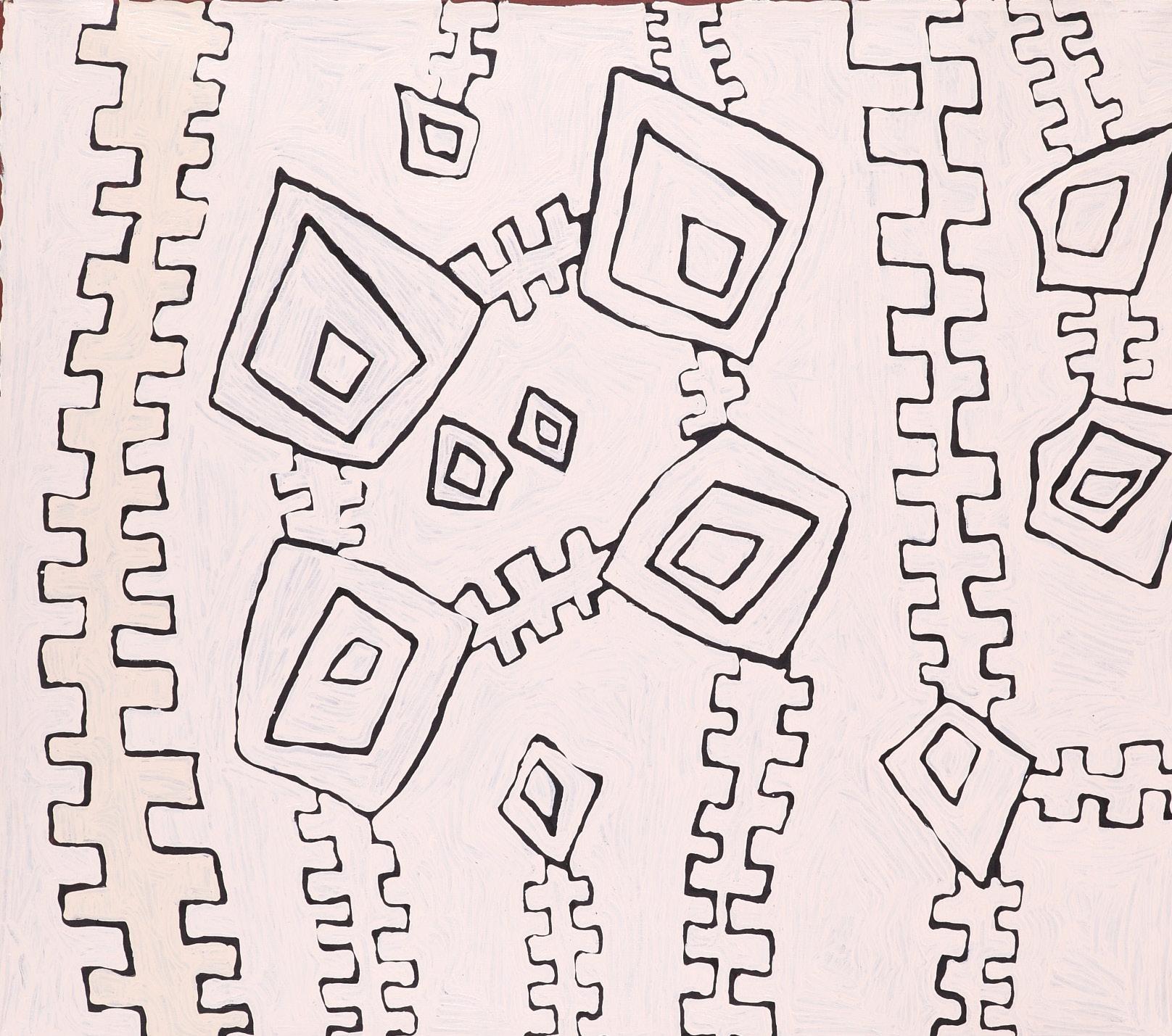
AUSTRALIAN, PITJANTJATJARA, C. 1930 - 2018
Harry Tjutjuna was born in the bush circa 1930 at a place known as Walytjatjara in northern South Australia. He was one of the most senior Law men of the area; few of his generation are still alive. He was also a revered Ngangkari (traditional healer). A native Pitjantjatjara speaker, Tjutjuna had strong family ties to the APY (Anangu Pitjantjatjara Yankunytjatjara) Lands in South Australia, and into the west towards Warburton Ranges.
As a young man, Tjutjuna went to school in Pukatja but he later moved on to work at a settlement where he sank bores, did fencing and gardening, and tended to the animals. He also worked as a stockman, mustering cattle for many years. Eventually Harry moved back to the far north-west with a large family, living in and around Irrun ytju (Wingellina) in Western Australia, and Pipalyatjara in South Australia.
Tjutjuna became a full-time artist in 2005 at Ernabella Arts before moving permanently to Pipalyatjara in 2008 where he has continued painting at Ninuku Arts Center. Harry’s knowledge of Tjukurpa (Dreaming stories) associated with the land surrounding Pipalyatjara was extensive and, due to his seniority, unmatched by most others. He painted a range of stories including Wati Wanka (Spider Man); Wati Nyiru, the man who chases seven sisters around and eventually marries one; and Kungka Tjuta – young girls telling stories traditional way by drawing designs in the sand (milpatjunanyi).
Tjutjuna’s whimsical themes, combined with his masterful use of the brush quickly positioned him as one of the most highly sought-after artists at Ninuku Art. His unique approach to painting, exhibiting a quirky representa tion and bold confidence has resulted in a strong collector base both within Australia and internationally.
Art Gallery of New South Wales
National Gallery of Victoria
National Gallery of Australia
Araluen Arts Center
Art Gallery of South Australia
Parliament House Collection
Kungka Tjuta, 2011
36 x 24 inches (91 x 61cm)
Acrylic on Canvas
Ninuku Arts Catalog #11546
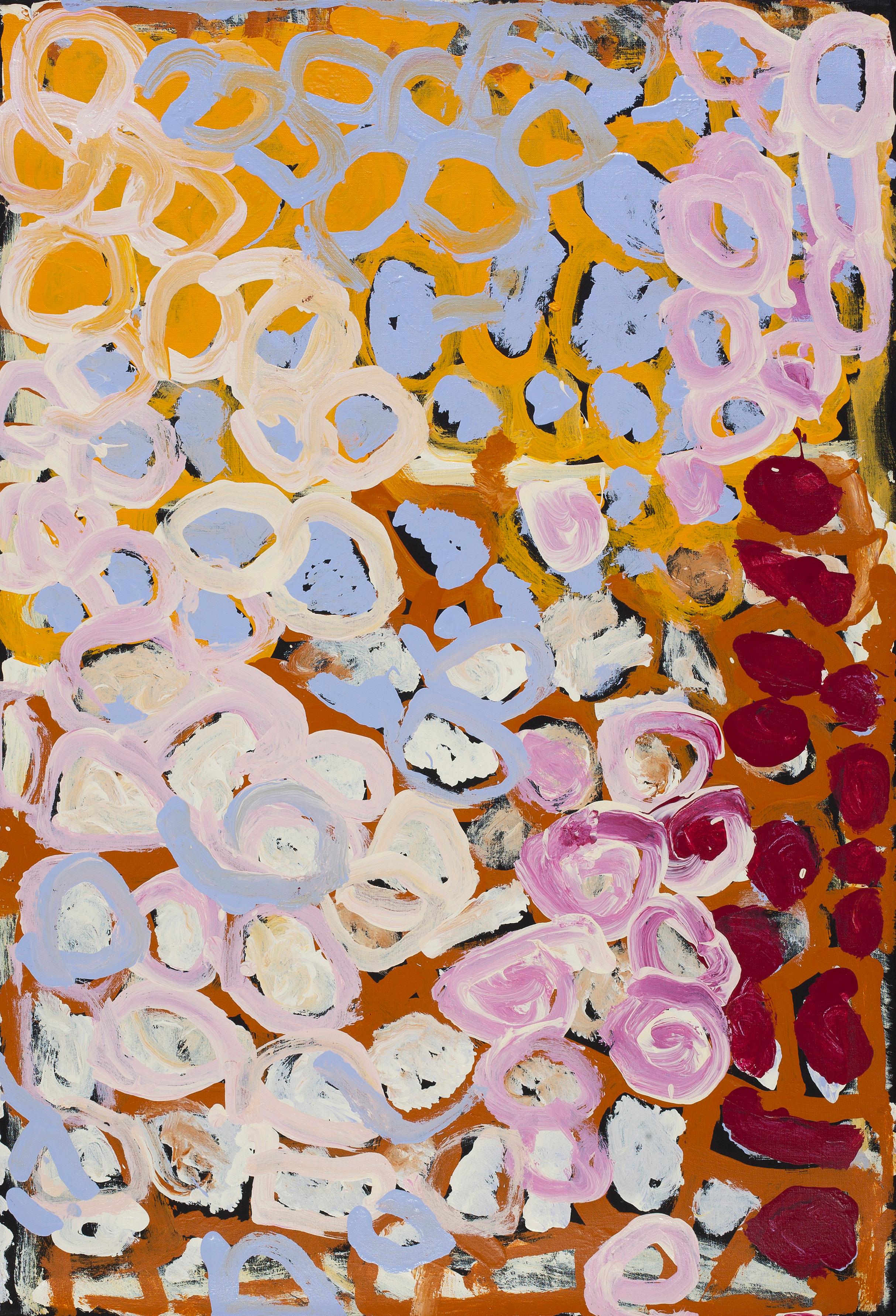
AUSTRALIAN, WARNMAN, C. 1929 -2019
Mabel Wakarta was born in the 1920s at Yirajarra, which is near Juntu Juntu well 30 on the Canning Stock Route in Western Australia. Her parents were both Warnman people whose country encompassed Tarl, Nayijara and Juntu Juntu. Mabel grew up in the pujiman (bush) way until, in a run of very bad seasons, her parents, her brother and her sister all passed away. Following this tragic loss, Mabel and some other family members walked through Karlamilyi (Rudall River), Talawana and into Jigalong Mission.
Mabel was an adult when she arrived at Jigalong and went to work cooking, washing and cleaning houses. She worked for many years on Roy Hill, Ethel Creek and Bonney Downs Stations as well as several stations to the south of Martu country. Mabel was married to Wakarta but he passed away in Jigalong a long time ago. Mabel painted her ngurra (home) and her warrarn (country) to teach the young so that they can learn to paint too.
When Mabel first started painting she was living in Irrungadji Community in Nullagine with Lily Long and Amy French.
National Museum of Australia
MABEL WAKARTA
Yirjarra, 2014 40 x 48 inches (152 x 122cm)
Acrylic on Belgian linen Martumili Artists #14-69

Adrian Jangala Robertson is a widely respected Warlpiri artist with a distinctive approach to landscape painting. His paintings refer to the desert lands, ridges and trees which are part of his mother’s country, Yalpirakinu, recalled through brushwork loaded with memories. Adrian’s father’s country travels from west of Walungurru through Karku at Nyirrpi to Warlurkurlangu at Yuendumu in the Northern Territory. Adrian is a landscape painter and captures the sweep of his country primarily using a limited palette and layering techniques bringing energy and drama to his works.
Adrian was born at Papunya in 1962. Growing up in Papunya at this time Adrian witnessed the Western Desert painting movement’s inception. As a boy attending school there, he remembers Geoff Bardon working as a school teacher alongside the early Western Desert painters. Adrian has since enjoyed strong artistic influences through out his life including his father’s brother, the late Darby Ross Jampijinpa and his mother, the late Eunice Napan gardi.
Since 2002 Adrian has painted with the Bindi Mwerre Anthurre Artists and has become a crucial member of the Alice Springs art community. Over those years Adrian worked alongside his greatest mentor and friend, the late Billy Benn Perrurle.
Adrian continues to expand his artmaking, avidly experimenting with new mediums and techniques that develop the scope of his artistic practice. Adrian is a deliberate and thoughtful painter; reworking, pushing and pulling the medium, and in doing so connecting to country. In 2020 Adrian was the Winner of the General Painting Award, Telstra National Aboriginal and Torres Strait Islander Art Award. In recent months he was also awarded winner of the 2022 Alice Prize.
National Gallery of Victoria National Gallery of Australia
Yalpirakinu, 2020 36 x 36 inches (91 x 91cm)
Acrylic on linen
Bindi Mwerre Anthurre Artists Catalog #219-20
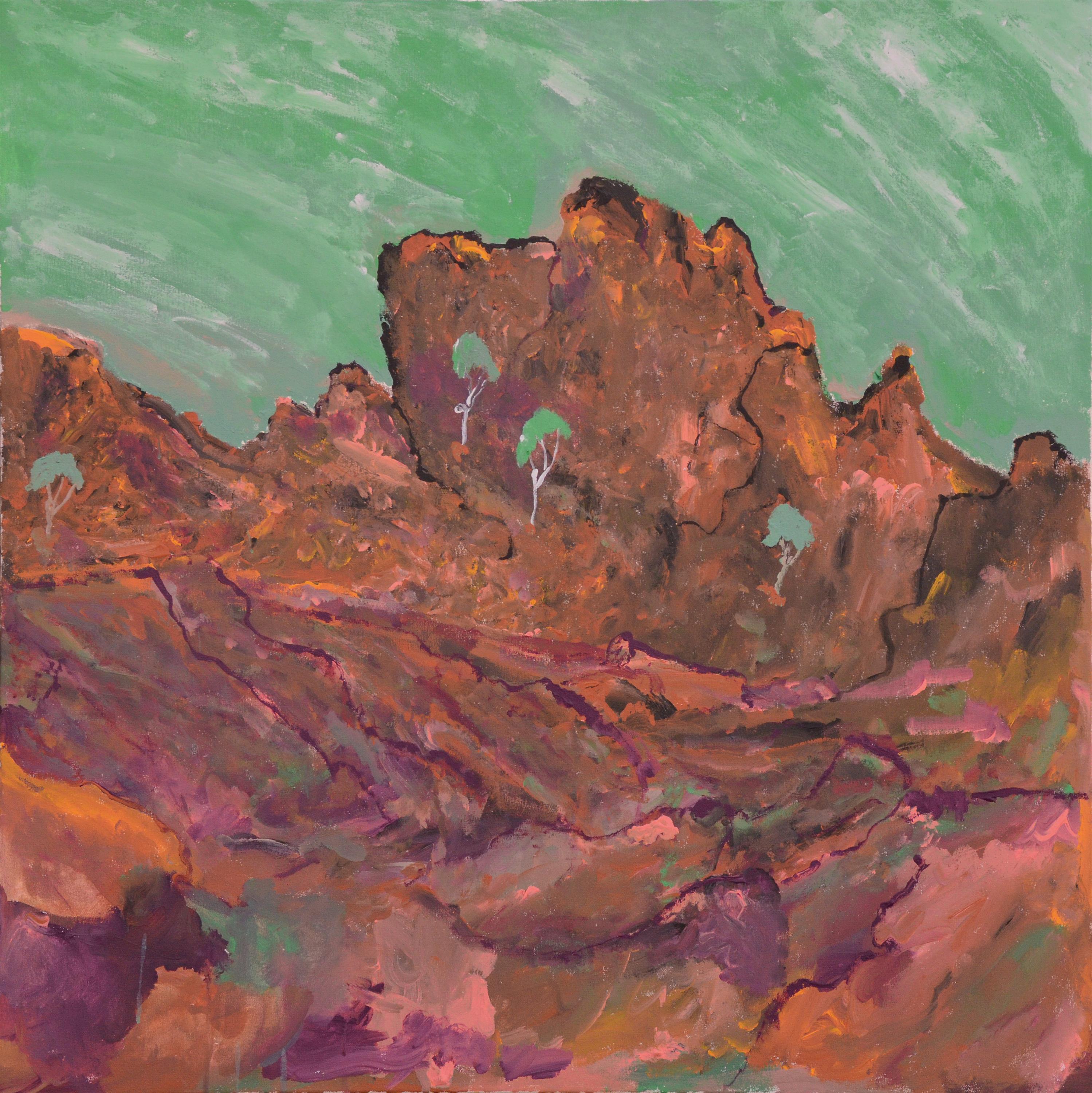
Jimmy Donegan was born at Yanpan, a rockhole near Ngatuntjarra Bore located within Ngaanyatjarra Lands a vast area within the state of Western Australia, adjoining the Northern Territory and South Australian borders. He grew up living the traditional nomadic lifestyle in the Pitjantjatjara and Ngaanyatjarra country around what is now the communities of Papulankutja and Mantamaru. Jimmy Donegan’s wife was born near Puta Puta, a place near Kalka in what is now the Anangu Pitjantjatjara Yankunytjatjara Lands (APY). He settled with his family at Papulankutja (then known as Blackstone) in the 1950s, because of his ties to that country.
Donegan is skilled as a wood craftsman, with his spears, spear throwers and boomerangs highly prized. His wife Nuuniwa Imundura Donegan, was also a craftswoman. She was a member of the Tjanpi Desert Weavers, a project of women producing artistic objects made mainly from grass (tjanpi), during the mid to late 1990s.
In August 2010, Jimmy Donegan won the most prestigious art prize in Australia - the Telstra National Aboriginal and Torres Strait Islander Art Award. He was the winner of two sections - the General Painting category and the overall prize.
A quote from The Australian Art Review November 2006, “His works are dazzling compositions of swirling, intensely-coloured dots, sometimes crossed by lines signifying the journey of the two snakes above and below the surface of the earth.”
Queensland Art Gallery
National Gallery of Victoria Laverty Collection
Merenda Collection
University of Western Sydney
JIMMY DONEGAN
Pukara, 2014 42 x 36 inches (107 x 91cm)
Acrylic on linen
Ninuku Arts Catalog #14-153
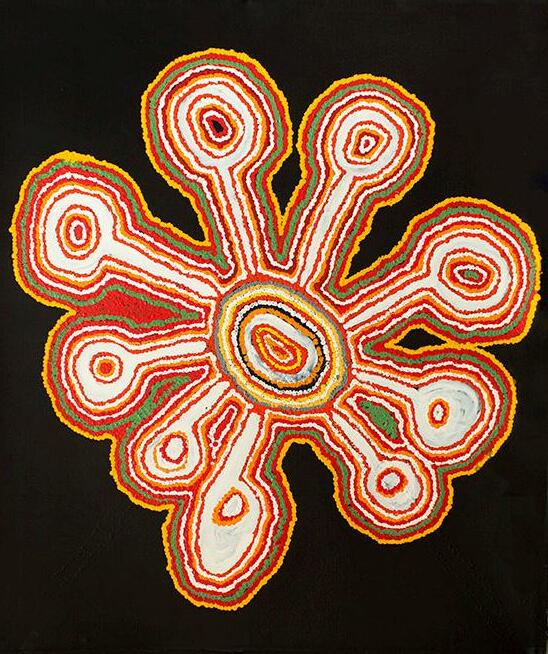
AUSTRALIAN, PINTUPI, C. 1930 - 2009
Tjunkiya was born at Rapalangya, north-west of the Kintore Community, c. 1930, and she is the third wife of Turkey Tolson’s father. She later moved to Haasts Bluff with her husband and then to the Papunya Community when it was established. She participated in the Kintore/Haasts Bluff joint project, which was the beginning of her career, but now paints solely for Papunya Tula. In 1999 Tjunkiya contributed to the Kintore women’s painting as part of the Western Desert Dialysis Appeal.
Tjunkiya passed away in Alice Springs after a brief illness in April 2009.
Art Gallery of South Australia National Gallery of Australia Artbank Sydney Museums & Art Gallery of the Northern Territory Araluen Art Centre
Art Gallery of New South Wales Musee du Quai Branly Artbank
Charles Darwin University Queensland Art Gallery
Untitled, 2007
36 x 36 inches (91 x 91cm)
Acrylic on Belgian linen Papunya Tula Catalog #TN0712021

